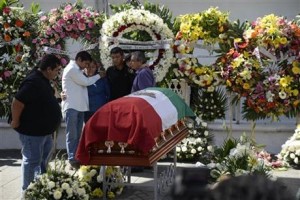
01/06/15 (written by kheinle) – The newly inaugurated mayor of Temixco, Gisela Mota, was gunned down in her home in Morelos on Saturday, January 2, just one day after being sworn into office. Mota (33) is one of nearly 100 mayors killed in Mexico in the past ten years, writes the Association of Local Authorities in Mexico (Asociación de Autoridades Locales de México A.C., AALMAC), 75 of which occurred between 2006 and 2014, according to Justice in Mexico. Documented in its Memoria dataset and noted in its annual publication, “Drug Violence in Mexico: Data and Analysis Through 2014,” Justice in Mexico reported that the peak of violence towards mayors in recent years was in 2010 when 17 mayors or former mayors were killed. For its part, the AALMAC renounced Mayor Mota’s killing and demanded the Mexican government find and hold accountable those responsible. Three suspects have since been detained, including one woman and one minor.
Mota’s murder falls in line with previous mayoral assassinations given its alleged ties to cartel and gang activity. As part of her mayoral campaign and as a former federal congresswoman, Mota had accepted state police control in her municipality and had stood tough against crime and violence, both stances that drew negative attention from local gangs. According to Morelos Governor Graco Ramirez, writes the Associated Press, Mota was killed by the Rojos gang “as a warning to other officials to reject state police control of local cops and [to] let cartels co-opt low-paid local officers.”

The former of Mota’s two stances—the state police control—is part of a bigger, nationwide shift to restructure police forces throughout Mexico. In November 2014, President Enrique Peña Nieto presented the plan to create a Unified Police Force following the disappearance of 43 students in Iguala, Guerrero, an incident that some have said was a result of gang fighting between the Guerrero Unidos in Guerrero and the Rojos gang in nearby Morelos, and that was compounded by the involvement of corrupt local police. Under the new model, Mexican police forces are being restructured to dissolve the nearly 1,800 municipal forces, which are notorious for being corrupted, and transfer power to the 32 state forces. By accepting state police, Mota, along with other mayors and officials nationwide, relinquished local police control, a move that is sometimes met with resistance. For her part, Mota had agreed to police control at the state level, but insisted, writes the Associated Press, that traffic cops would stay under local control in Temixco. Nevertheless, Los Rojos still targeted Mota, sending a message to other mayors and officials nationwide.
Not only is the federal government revamping the police structure to address corruption and inefficiencies at the local level, but it is also requiring police training nationwide in preparation for the New Criminal Justice System (Nuevo Sistema de Justicia Penal, NSJP). With less than six months until the NSJP must be implemented and operational throughout Mexico, the Washington Office on Latin American (WOLA) reported in September 2015 that at that time, “only approximately five percent of Mexican police officers [had] been trained on the criminal justice system reforms.” WOLA continued, “This means that 95 percent of Mexican police officers (over 333,000 agents) not only need to learn the new justice system but also how to conduct successful and rights-respecting criminal investigations, including crime scene preservation, evidence collection, and preliminary interviews with witnesses.” Police reforms and trainings are thus expected to continue in the New Year, especially in the first six months prior to the NSJP June 2016 deadline.
Sources:




